Tarnished Plant Bugs
go.ncsu.edu/readext?647922
en Español / em Português
El inglés es el idioma de control de esta página. En la medida en que haya algún conflicto entre la traducción al inglés y la traducción, el inglés prevalece.
Al hacer clic en el enlace de traducción se activa un servicio de traducción gratuito para convertir la página al español. Al igual que con cualquier traducción por Internet, la conversión no es sensible al contexto y puede que no traduzca el texto en su significado original. NC State Extension no garantiza la exactitud del texto traducido. Por favor, tenga en cuenta que algunas aplicaciones y/o servicios pueden no funcionar como se espera cuando se traducen.
Português
Inglês é o idioma de controle desta página. Na medida que haja algum conflito entre o texto original em Inglês e a tradução, o Inglês prevalece.
Ao clicar no link de tradução, um serviço gratuito de tradução será ativado para converter a página para o Português. Como em qualquer tradução pela internet, a conversão não é sensivel ao contexto e pode não ocorrer a tradução para o significado orginal. O serviço de Extensão da Carolina do Norte (NC State Extension) não garante a exatidão do texto traduzido. Por favor, observe que algumas funções ou serviços podem não funcionar como esperado após a tradução.
English
English is the controlling language of this page. To the extent there is any conflict between the English text and the translation, English controls.
Clicking on the translation link activates a free translation service to convert the page to Spanish. As with any Internet translation, the conversion is not context-sensitive and may not translate the text to its original meaning. NC State Extension does not guarantee the accuracy of the translated text. Please note that some applications and/or services may not function as expected when translated.
Collapse ▲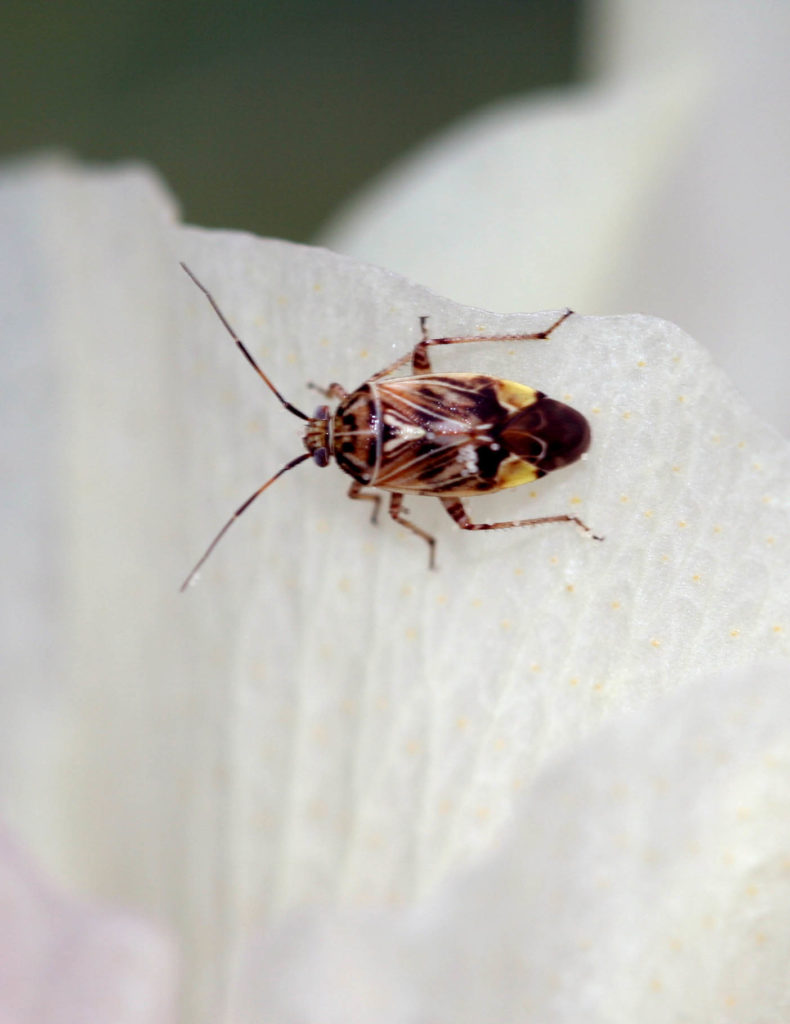 Before cotton blooms tarnished plant bugs, or Lygus, damage the crop by feeding in tender terminals and, more commonly, directly on small squares with their needle-like mouthparts, causing the squares to abort. When blooming begins, plant bugs continue to feed not only on the smaller squares, but also on larger squares and even small bolls. Tarnished plant bug feeding on large squares just prior to opening cause“dirty blooms” (white blooms with darkened pollen anthers, and sometimes with small circular deformities on the petals).
Before cotton blooms tarnished plant bugs, or Lygus, damage the crop by feeding in tender terminals and, more commonly, directly on small squares with their needle-like mouthparts, causing the squares to abort. When blooming begins, plant bugs continue to feed not only on the smaller squares, but also on larger squares and even small bolls. Tarnished plant bug feeding on large squares just prior to opening cause“dirty blooms” (white blooms with darkened pollen anthers, and sometimes with small circular deformities on the petals).
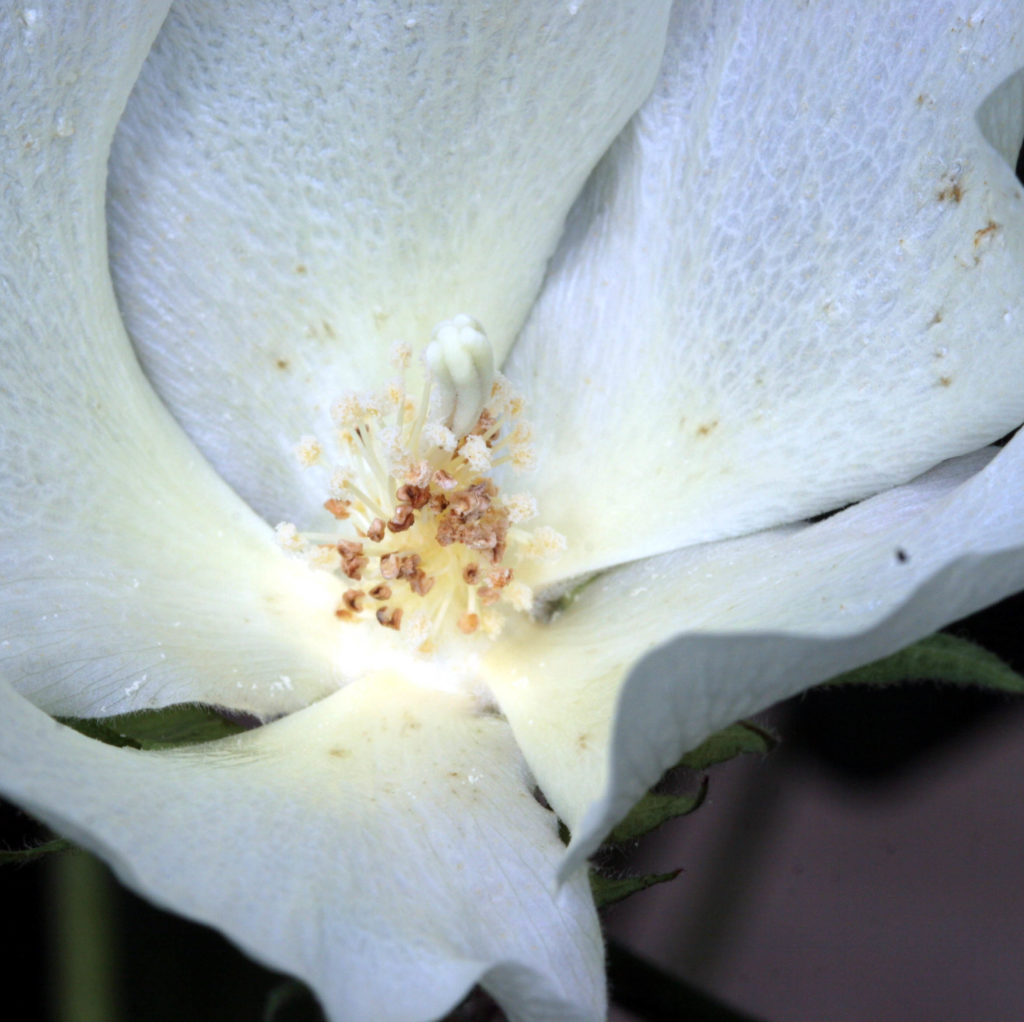 Tarnished plant bug feeding on small to medium-sized bolls up to approximately 10 to 12 days old may cause stink-bug-like external boll spotting and internal boll damage, such a callous growth (warts), deformed or rotted fruit, or small boll abortion. This boll damage is identical to that caused by stink bugs. Plant bug damage has become more widespread in recent years, particularly in eastern counties. Plant bugs are capable of causing all of the damage symptoms described in Table 2.
Tarnished plant bug feeding on small to medium-sized bolls up to approximately 10 to 12 days old may cause stink-bug-like external boll spotting and internal boll damage, such a callous growth (warts), deformed or rotted fruit, or small boll abortion. This boll damage is identical to that caused by stink bugs. Plant bug damage has become more widespread in recent years, particularly in eastern counties. Plant bugs are capable of causing all of the damage symptoms described in Table 2.
| Plant Stage | Plant Part | Bug Type | Damage Symptoms |
|---|---|---|---|
| Pre-Bloom | Terminals | Plant Bug | With heavy feeding, terminals may be deformed or killed, resulting in a loss of apical dominance (sometimes called “crazy cotton”). |
| Small Squares | Squares yellowing, turning brown, then black, and finally aborting, leaving a scar. Sometimes square will remain externally yellow (dirty square) from plant bug frass (excrement). | ||
| Blooming | Various Squares | Plant Bug | Small squares, same as above; larger squares often show internal damage to pollen anthers. |
| White Blooms | Darkened pollen anthers (dirty blooms); petal deformations. | ||
| Bolls | Plant Bugs & Stink Bugs |
Aborted small bolls; external spotting; internal feeding “stings”; wart-like growths; stained lint, often in seed area; damaged seed. |
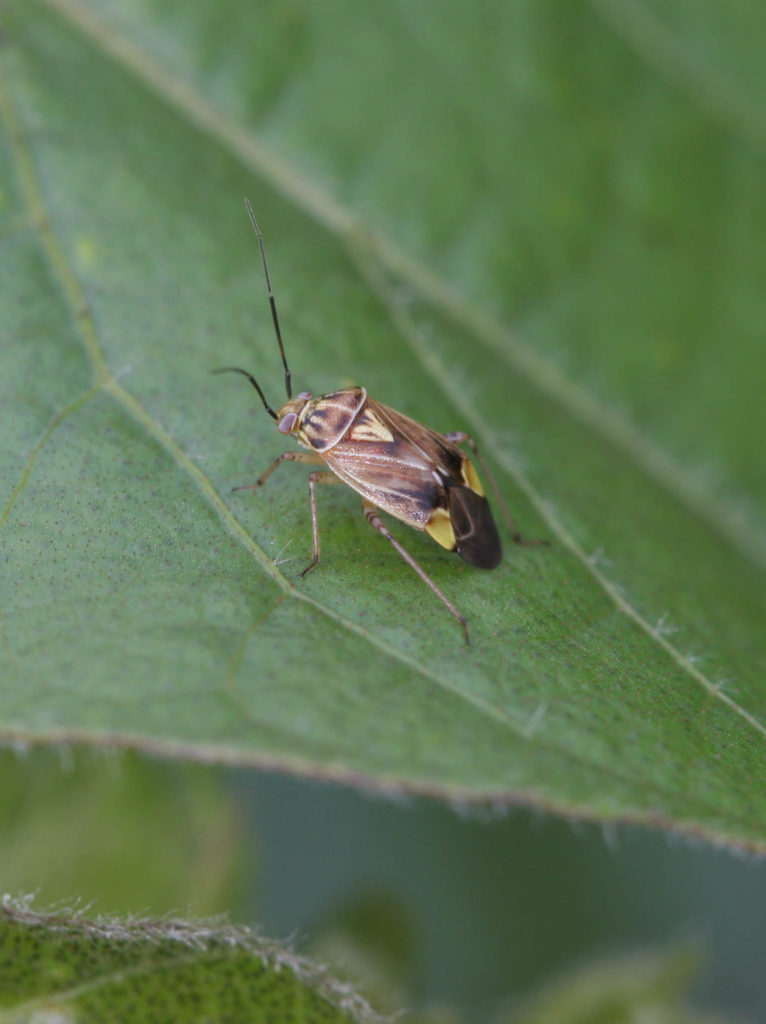 Early season monitoring for tarnished plant bug activity is recommended, especially retention counts of small squares (approximately 1/8 to 3/16 inch long, including bracts). If square retention remains high (greater than or equal to 80 percent), further, more comprehensive sampling for live tarnished plant bugs is probably unnecessary. If retention rates of small, upper, and other first- or second-position squares drop below this level, further sampling for live tarnished plant bugs may be needed. Usually, one terminal square (or its missing position) and one first or second position square (or its missing position) two or three nodes from the top of the plant are inspected per plant from 25 randomly selected plants within a field (50 squares total). Sweep net sampling for tarnished plant bug adults and large nymphs typically involves taking of 25 sweeps at 6 to 10 locations per cotton field.
Early season monitoring for tarnished plant bug activity is recommended, especially retention counts of small squares (approximately 1/8 to 3/16 inch long, including bracts). If square retention remains high (greater than or equal to 80 percent), further, more comprehensive sampling for live tarnished plant bugs is probably unnecessary. If retention rates of small, upper, and other first- or second-position squares drop below this level, further sampling for live tarnished plant bugs may be needed. Usually, one terminal square (or its missing position) and one first or second position square (or its missing position) two or three nodes from the top of the plant are inspected per plant from 25 randomly selected plants within a field (50 squares total). Sweep net sampling for tarnished plant bug adults and large nymphs typically involves taking of 25 sweeps at 6 to 10 locations per cotton field.
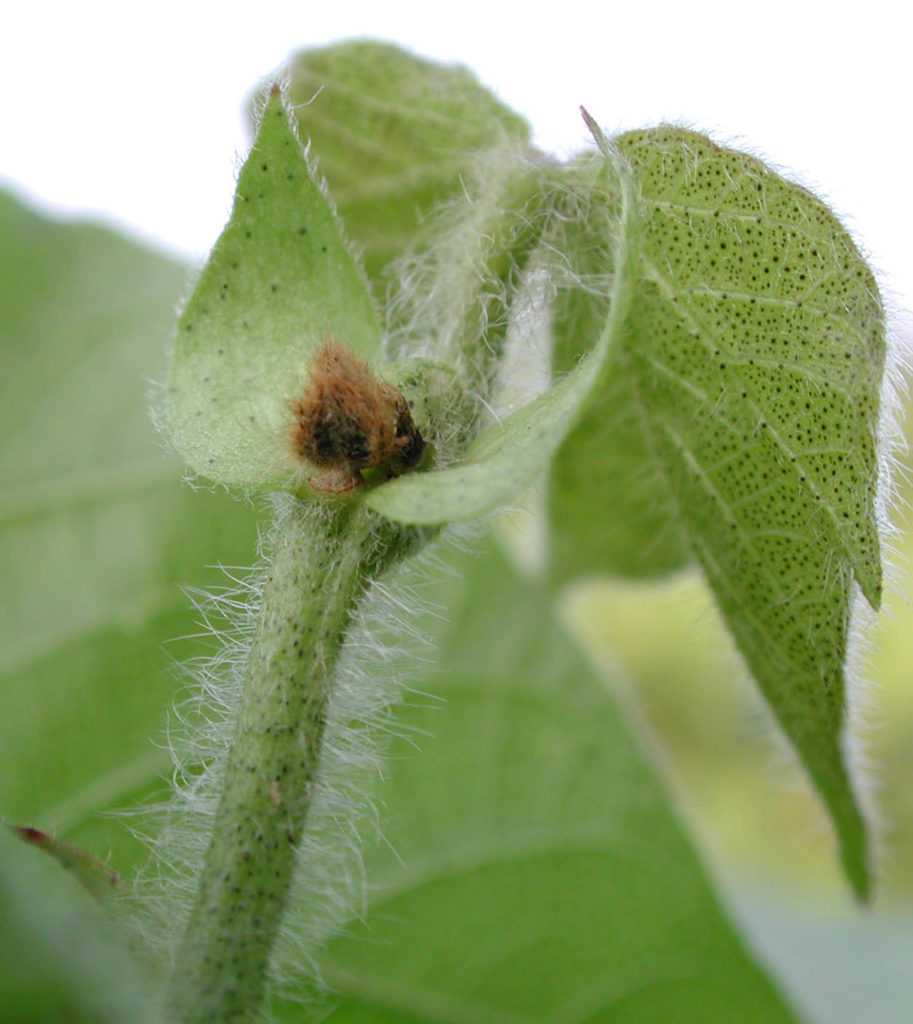 Be mindful of field edges along ditch banks, adjacent host plants such as weedy flowering fields, or where Irish potatoes or a substantial acreage of corn is present. These areas are often a likely source of migrating adult tarnished plant bugs. In taking samples from randomly selected sweeping sites, pay attention to possible differences in plant bug distributions, particularly changes in levels from the edge to the interior of the field. Significantly higher levels around field perimeters may indicate an invading tarnished plant bug population. Try to initiate samples not less than 50 feet from the field edge, since there are more tarnished plant bugs near field edges and densities are variable. Finally, smaller fields with more “edge” than “interior” are more at risk for infestation than larger fields. Sweep at least 12 locations in the field.
Be mindful of field edges along ditch banks, adjacent host plants such as weedy flowering fields, or where Irish potatoes or a substantial acreage of corn is present. These areas are often a likely source of migrating adult tarnished plant bugs. In taking samples from randomly selected sweeping sites, pay attention to possible differences in plant bug distributions, particularly changes in levels from the edge to the interior of the field. Significantly higher levels around field perimeters may indicate an invading tarnished plant bug population. Try to initiate samples not less than 50 feet from the field edge, since there are more tarnished plant bugs near field edges and densities are variable. Finally, smaller fields with more “edge” than “interior” are more at risk for infestation than larger fields. Sweep at least 12 locations in the field.
 Once blooming has been underway for 1 to 2 weeks, square retention is a less reliable indicator of possible tarnished plant bug feeding, due to natural square loss for mostly weather-related reasons. In blooming cotton, the presence of tarnished plant bugs and their damage is best assessed by continuing fruit examinations, evaluating dirty blooms, and by the use of a black beat sheet (i.e., ground cloth).
Once blooming has been underway for 1 to 2 weeks, square retention is a less reliable indicator of possible tarnished plant bug feeding, due to natural square loss for mostly weather-related reasons. In blooming cotton, the presence of tarnished plant bugs and their damage is best assessed by continuing fruit examinations, evaluating dirty blooms, and by the use of a black beat sheet (i.e., ground cloth).
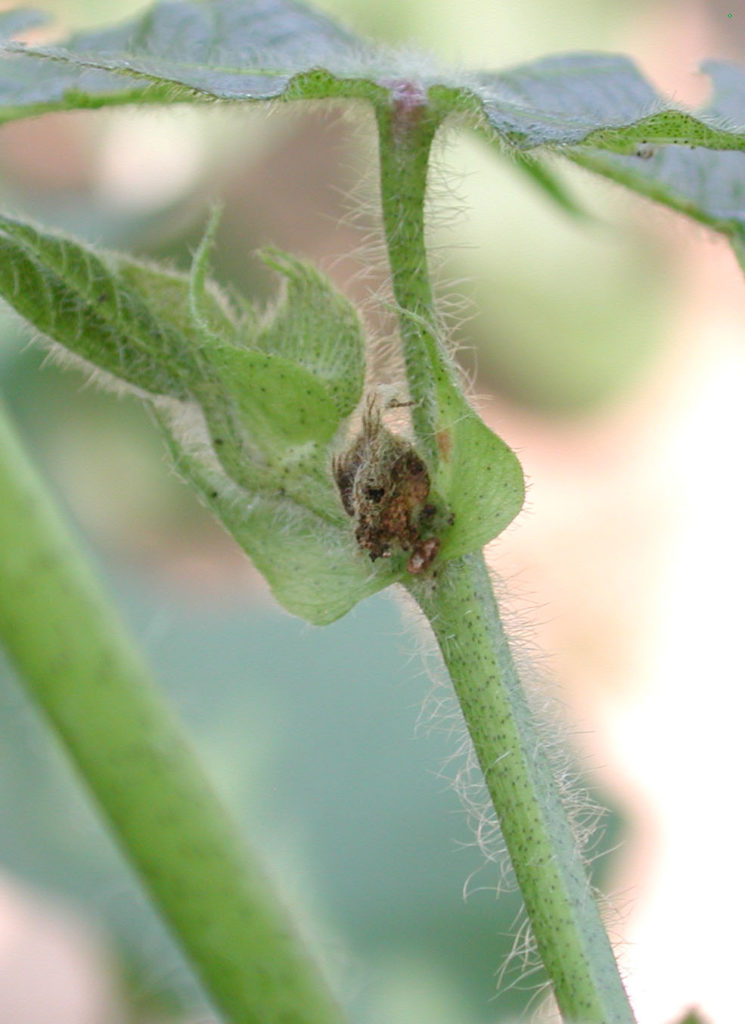 Tarnished plant bug feeding on large squares damages their pollen anthers which subsequently show up as easy-to-spot brownish to black anthers when the flower opens. Although we do not recommend the use of a dirty bloom threshold, dirty blooms are easy to spot and may indicated tarnished plant bug activity.
Tarnished plant bug feeding on large squares damages their pollen anthers which subsequently show up as easy-to-spot brownish to black anthers when the flower opens. Although we do not recommend the use of a dirty bloom threshold, dirty blooms are easy to spot and may indicated tarnished plant bug activity.
 During the bloom period, a black beat cloth (also called a ground cloth, drop cloth or shake sheet) is probably the best tool to access live tarnished plant bug levels. The rolled-up cloth is unfurled between two rows to the base of the plants and the cotton plants are firmly beaten onto the area between the rows covered by the cloth. This video below covers the proper use of the black beat cloth. Because tarnished plants bug may be active, they should be counted quickly. Sample at least 10 locations in the field.
During the bloom period, a black beat cloth (also called a ground cloth, drop cloth or shake sheet) is probably the best tool to access live tarnished plant bug levels. The rolled-up cloth is unfurled between two rows to the base of the plants and the cotton plants are firmly beaten onto the area between the rows covered by the cloth. This video below covers the proper use of the black beat cloth. Because tarnished plants bug may be active, they should be counted quickly. Sample at least 10 locations in the field.
Researchers have found that the small tarnished plant bug nymphs are much easier to identify on a black beat cloth than older standard white beat cloth. Scouts should be aware that tarnished plant bugs may be more common at field edges or in rank areas. These trends should be noted by scouts, as they are sometimes taken into consideration in making treatment decisions. However, this occurrence also points out the need to sample randomly from throughout the cotton field.
Tarnished Plant Bug Thresholds
Pre-bloom: Tarnished plant bug sweeping advised where retention of young terminal and lateral squares in pre-bloom cotton is less than 80 percent.
- 8* plant bugs per 100 sweeps (from initiation of squaring until the first or second week of blooming) AND <80% square retention.
*The sweep net threshold may be raised to 10 if fruiting begins on node 4 through 6, or lowered to 6 or 7 if fruiting has begun on node 8 or higher. Thresholds also may be lowered somewhat in stressed cotton.
Post-bloom: Post-bloom thresholds begin approximately 1 to 2 weeks after bloom initiation.
- 2-3** adult plus nymph stage plant bugs per 5 row feet taken from 6 to 8 locations in the field.
** Use 2.5 foot black beat cloth between two adjacent cotton rows.


